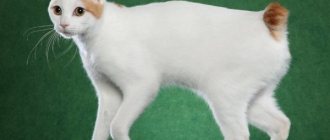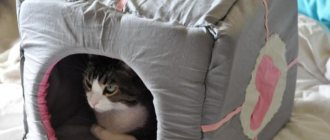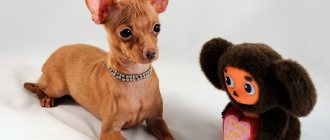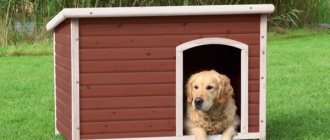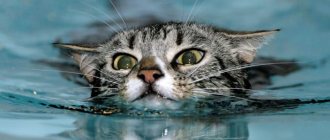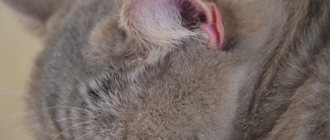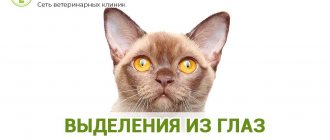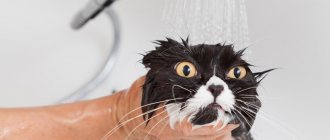Origin story
Among the ancestors of the Kuril Bobtail are the famous Japanese Bobtail: stately and strong cats with the same short tails and a “dancing” gait.
The Japanese kept these animals in temples and revered them as sacred objects, but the craving for a free life often took precedence over their usual comfort, and the cats ran away into the wild. Once on the Kuril Islands, Japanese bobtails began to change noticeably: the cats increased in size, their coat color changed, and their claws stopped retracting inward. And over time, when Russian settlers brought their favorites to the islands - wonderful fluffy Siberian cats - they became friends with them.
As a result of the mixing of blood, the modern Kurilian Bobtail was born - an outstandingly sized cat with thick dense hair and a funny pom-pom tail. Their amazing agility, unfailing hunting instinct and good health captivated people and in the late 80s, cat lovers started talking about them as a full-fledged breed. The first standard was adopted by the Soviet Felinological Federation in 1991, the general one (WCF) - in 1995.
Today it is not difficult to buy a Kurilian Bobtail kitten. There are quite a lot of nurseries operating in Russia, and there is no shortage of private breeders. The cost depends not only on the appearance, but also on the titles of the parents, the conditions of keeping and raising the animal. The price tag starts from 20,000 rubles. Taking an animal from your hands and without documents is fraught with problems in the future.
Caring for the Kurilian Bobtail
For two centuries (and maybe more), kurbobs managed themselves on the Kuril Islands. It was not the man who helped them, but they – the man. They caught rodents and protected the food of forwarders from invasions of small animals. Do I need to explain how easy it is to care for these beautiful animals now?
Perhaps only the cat’s fur deserves special attention. And the owner needs this more than the kurbob. Most often, these cats are fluffy and shaggy. This means that their long fur needs to be combed more often – twice a week. The animal will not look worse without these procedures, but you will quickly get tired of collecting matted hair from the sofa, carpet and all the clothes in the house. So you definitely need to comb it!
Well, cats need to be bathed more often. Long fur gets dirty very quickly. Bobtails love water very much and are excellent swimmers. Under natural conditions, they themselves regularly bathe in rivers. Therefore, please, give your pet a bath as often as possible.
Feeding the Kurilian Bobtail
We remember that Siberians are predators. The diet of tailless cats should be as close to natural as possible. On the islands, bobtails feed on what they find or catch. Domestic Kurilian Bobtails do not require expensive premium food or cat vitamin complexes. This type of food should be given to your bean only if you have a show-class animal that you are preparing to participate in exhibitions. In other cases, the most common dry food plus meat is quite suitable.
Do not give your cat tubular bones (for example, chicken bones)! Sharp fragments can damage your predator's throat or esophagus. This is deadly!
Experts advise giving kurbobs not only meat fillet. Be sure to gnaw on something: hearts, stomachs, bones. By the way, Siberians are partial to fish! Sometimes treat your cat with fish.
Standards
| Standard | Description |
| Eyes | Rough, large and expressive. The iris can be any (snow-white cats have both blue and multi-colored eyes). |
| Head | Large, with smooth, rounded contours, wedge-shaped. The ears are small, with a wide base and rounded tips. They are slightly inclined forward and are equipped with tassels like those of a lynx. The whisker pads are plump and well expressed. The nose is of medium size, wide, level and straight. The chin is clearly defined, massive, with rounded edges. |
| Torso | The body is powerful, long, with developed muscles and strong bones. The hips are raised, the chest is wide. The limbs are not short, but they cannot be called long either. Powerful and strong. Paws are oval, large, spread out. |
| Tail | The tail is a distinctive feature of the Kurilian Bobtail. Outwardly it looks like a soft fluffy pompom. The length can be different: in cats with semi-long hair - 11-13 cm, with short hair - 1.5-8 cm. There is an undercoat, but it is quite small. |
| Wool | The coat can be semi-long or short. Bobtails with short hair have the same length all over their body. Cats with semi-long hair always have a fluffy collar, “pants” on the hind legs, socks and a plume on the tail. |
Felinologists distinguish 4 types of tails:
- Longest: includes 5-7 vertebrae. At first they form a straight line, and then twist into a loop. But such a tail is considered a serious drawback.
- Tail-broom: here there can be even more vertebrae - 8 or even 10. But the tail remains straight.
- Spiral tail: Also 5-10 vertebrae forming a small hook or spiral.
- The last and shortest tail is a stump. Consists of a minimum of 2 and a maximum of 8 vertebrae that are seriously deformed.
Weight table by month
The weight of an adult Kuril Bobtail reaches 4-7 kg, in cats - 5-9 kg.
| Age | Cat | Cat |
| 1 month | 280-400 gr | 330-460 gr |
| 2 | 550-750 gr | 880-1.2 kg |
| 3 | 1-1.2 kg | 1.1-2.2 kg |
| 4 | 1.3-2.4 kg | 1.8-3.2 |
| 5 | 1.7-2.7 kg | 2.6-3.6 |
| 6 | 2.6-3.4 kg | 3-4.4 kg |
| 8 | 3-4.1 kg | 4-5.2 kg |
| 10 | 3.2-4.4 kg | 4.4-5.8 kg |
| 1 year | 3.5-5 kg | 5-6.8 kg |
| 2 | 3.8-6 kg | 5.4-6.6 kg |
General description of the Kuril Bobtail breed
Kurilian Bobtail
cat can be called a “lynx in miniature.” Approximately the same body structure, the same smooth movements, a short stubby tail, a characteristic pockmarked coat color - all this is a smaller copy of a wild predator.
The Kurilian Bobtail has:
- muscular and compact body of medium size,
- smooth curves of the body,
- the head is shaped like an equilateral triangle with roundings,
- the forehead smoothly transitions to a straight nose,
- low cheekbones,
- full cheeks,
- strong chin.
Body structure:
The hind legs of bobtails are noticeably longer than the front ones.
The body of the animal is strong, but not rough, slightly elongated. The limbs are of medium length, the paws are round, the tail is very short, shaped like a “pompom”. The length of the tail is no more than 10-12 cm. It is well pubescent, composed of 2-12 diversified vertebrae and can be characterized by varying mobility.
A distinctive feature of the Kuril Bobtail, in addition to the practically absence of a tail, is the structure of the paws. The hind legs are slightly longer than the front legs, which is why cats of this breed are always slightly tilted downwards.
Another feature is that the claws do not retract into the pads, so when bobtails walk on the floor, a slight clicking sound is heard, like from a small dog.
In addition, they have an agile gait
like a wild cat stalking its prey.
Head structure:
The ears are set high and wide, rounded at the ends and have characteristic brushes.
The Kurilian Bobtail's eyes are slightly slanted, medium in size and almond-shaped, not protruding or deep. According to standards approved in 1995, the color of a cat's eyes must correspond to a certain color. Any shade of yellow-green eye color is acceptable.
Weight and body size of Kurilian Bobtails
Active growth of Kurilian Bobtails usually ends when the kitten is 6-7 months old. Thus, already at 7 months you can understand how large your cat will be. The body size is standard; there are no exact parameters for what a cat of this breed should be.
Average weight
adult Kurilian bobtails: males - 4-6 kg, females - 3-4 kg. But there are also heavyweights: cats can weigh up to 5.5 kg, males - up to 9.5 kg.
How long do Kurilian Bobtails live?
The life expectancy of Kurilian Bobtails is different compared to cats of other breeds. On average, bobtails live 15-20 years.
Colors
Colors are varied, but certain colors are prohibited in most show systems: fawn, lilac, chocolate, cinnamon, acromelanic (Tonky, Siamese and Burmese) and ticked colors.
The amber color was discovered only recently and has not yet been included in the general standard.
Acceptable colors:
- Tortoiseshell and solid (black, red, cream, blue, white);
- Tabby;
- Marble (red, black, blue, cream, tortoiseshell);
- Brindle (black, red, tortoiseshell, cream, blue);
- Spotted (red, black, blue, cream, tortoiseshell);
- Harlequin (including marble);
- Bicolor;
- Wang;
- With white spots.
In the photo there are cats of the Kuril Bobtail breed of popular colors: black, white, tortoiseshell
Character and behavior
The Kurilian Bobtail is often compared to a dog, which is not surprising: in devotion to humans, this cat breed rivals all those you know. These cats are calm, affectionate and gentle creatures who, however, can quite stand up for themselves. People are adored and immediately upon arriving in a new home, they choose a leader, whom I will follow through thick and thin.
Your movements around the apartment will not go unnoticed: bobtails will follow you on your heels, trying to show you their devotion and readiness to help in business. Even if such obsession annoys you, you will have to come to terms with it: bobtails have curiosity and a desire to be in company until they are very old.
He gets along with other pets without problems, but this applies exclusively to dogs and cats. Small animals (birds, hamsters, rats, chinchillas) are potential prey for bobtails, which they will chase until they catch them.
Other family members are potential friends for the bobtail. Cats treat children very kindly, carefully and patiently. They will not allow themselves to let out their claws or bite a child, so do not worry about leaving your Kurilian Bobtail and your toddler alone.
What does this pose mean in cats: crouching to the ground, arching their back, starting a mournful song?
Mating gamesPreparing for a fight
Character and intelligence of the bobtail
Friendliness
Despite the fact that the Kuril Bobtail is very similar to a wild lynx, it is a surprisingly kind and cheerful animal that loves human company and gets along well with all household members.
In terms of devotion to its owner and boundless friendliness, it is rather a dog
than a cat. She always tries to be close to people, is interested in their affairs, and has a pleasant and unique voice.
Bobtails love to sit on people's laps, to be in the center of all events, but at the same time they are unobtrusive. If they see that the owner has no time for them right now, then they do not particularly insist on the next portion of attention to their person.
But it is important to remember that cats of this breed are very attached to their owner.
, and if you are away from home for a long time, your pet will be very bored.
Get along with children and other animals
Unlike most other cat breeds, bobtails do not “walk on their own”, but look for opportunities to follow people everywhere. Along with this, they are extremely patient and never offend children, even if they constantly drag them around, pull their ears, etc.
If there are other cats of the same breed living in the house, they almost never quarrel and are even able to establish their own hierarchy.
In addition, they are distinguished by amazing courage, are not afraid of dogs at all and make friends with them.
Activity
Kurilian Bobtails are active and curious cats
It is important to understand that these cats are very active. They need free space to play, jump, run and climb. They can jump very high and climb into the most inaccessible places. However, damage to household property from their “adventures” is no greater than from representatives of other breeds.
An interesting feature of Kurilian Bobtails is their love of water.
, they swim, dive perfectly and are even able to catch fish in a pond on their own. The hunting instinct of these animals is simply excellent. They enjoy catching mice and rats.
Intelligence
Bobtails are very smart and easily remember what they are allowed to do and what they are not allowed to do.
The Kurilian Bobtail can be taught to walk on a leash, perform tricks and even play games.
An important and useful feature of these cats is that they almost never mark their territory. This, of course, can happen, but only if cats of a different breed live in the house.
Care instructions
Wool
The Kurilian Bobtail's coat does not tangle and is not prone to tangles, so you should not brush them more than 1-2 times a week. These cats simply love to swim (by the way, Kurilian Bobtails are not only good hunters, but also excellent fishermen), so bathe them once every 1-2 months.
Claws
They get accustomed to the scratching post quickly and do not need additional nail trimming.
Eyes
But you need to watch your eyes and ears. Both are wiped with a damp cotton pad soaked in hydrogen peroxide, tea leaves or chlorhexidine.
Teeth
Teeth are brushed 2-4 times a week using a special toothbrush with soft bristles and cat toothpaste (Bars, Doctor ZOO).
In the photo there are cats of the Kuril Bobtail breed: short-haired and semi-long-haired
Contents of the Kurilian Bobtail
It is not difficult to keep Kurils - they need to be provided with a place to spend time and play. You can find various multifunctional complexes on sale, but it is better to make them to order, providing various multi-level and multi-tiered platforms, beds, ladders, tunnels, toys, houses, scratching posts, etc.
Nutrition
Kurilian Bobtails are not picky about their diet. They can be fed with natural products and ready-made premium formulations, selected according to the age of the pet.
You cannot mix different types of food. This will inevitably have a detrimental effect on the health of the animal.
Quantity and composition of food
The diet of the Kuril Bobtail should be as close as possible to the food that the animal consumed in the wild. The portion is calculated based on the amount of 30–35 g of feed per 1 kg of live weight.
It is recommended to create a menu for smokers from the following products:
- lean raw meat (beef, turkey, rabbit, etc.);
- boiled and raw eggs;
- sea fish;
- boiled vegetables;
- boiled offal (tripe, heart, lungs, etc.);
- grain porridges (rolled oats, buckwheat, yachka, etc.).
Experienced breeders do not advise giving bobtails dairy products and potatoes, because they are poorly absorbed by their bodies.
Kurilian Bobtails need to be fed meat
Raw meat must be disinfected before consumption. To do this, it is frozen for at least 12 hours, then filled with hot water and fed completely thawed.
Kittens are introduced to dry food starting at 3–4 months. Experienced breeders advise feeding your pet ready-made premium and super-premium granules (Royal Canin, Hill's, Pro Plan, etc.).
How many times a day should you feed your pet?
Small kittens are fed strictly according to a schedule - at least 5-6 times a day. Gradually, the number of feedings is reduced and by the age of one year they switch to two meals a day (morning and evening).
The bowl should always contain fresh, clean water, which should be changed daily
Almost all cats love to drink from large containers. Our cat flatly does not recognize a bowl of water; she definitely needs to drink from a ladle in which water for watering flowers settles. She will make her way to the shelf where it stands, long and persistently. Although the water is in your own cup right under your nose. It’s even better to drink from a bucket or basin. My sister keeps a special bucket of water in the bathroom for her cat. If suddenly it is needed for some other purpose, and it is not there, then the pet is wildly indignant.
The role of a balanced diet in cat health
Since Kurilian Bobtails are a natural breed, it is especially important to pay attention to a balanced diet to maintain their well-being and health.
The meat and fish component should be at least 2/3 of the total food consumed. When eating natural foods, you must add vitamin and mineral complexes to your diet. Ready-made professional food already contains all the necessary ingredients.
Many cats happily eat special cat grass.
Appearance care
Bobtails do an excellent job of taking care of their own appearance. They are distinguished by cleanliness and constantly lick themselves.
Brushing and bathing
The coat of cats of this breed is not prone to matting and matting, so they do not need to be brushed often. It is enough to remove dead hairs with a special brush 1-2 times a week.
Kurilian bobtails are brushed once a week
Water procedures are carried out as needed, usually no more than once every 3-4 months.
Often bathing animals is harmful, as the fur becomes thinner, its quality characteristics deteriorate, and the skin dries out.
Eye and ear care
The ears should be inspected approximately once every 7–10 days and any contamination should be carefully removed with a cotton swab dipped in a special solution for caring for animal ears, hydrogen peroxide or chlorhexidine. Eyes should be wiped every day with a cotton pad soaked in warm boiled water or a pharmaceutical eye care solution.
On sale you can find special wipes for animals to care for eyes and ears.
Nail care
Since bobtail claws do not retract completely, they require special care. They will have to be slightly shortened approximately once every 10–15 days. It is better to use a special nail clipper. It is imperative to provide your pet with several good scratching posts of different designs so that he can take care of his claws himself.
The claws are trimmed with special scissors (claw clippers)
Dental care
Teeth are brushed once a week with a special soft brush and paste for animals that does not require rinsing.
Toilet
Any large open litter box will do for Kurilian Bobtails, as these cats are quite large. They do not make any special claims to the filler, so its choice depends only on the financial capabilities of the owner and his personal preferences.
For the Kurilian Bobtail you need to choose a large open tray
At first, kittens are advised to pour absorbent filler (wood, paper) into the tray. It will not harm the baby's digestive system if he accidentally swallows the granules.
Walks
Walking plays a big role in the life of Kurbobs. They must be taken with you on all trips to nature. If this is not possible, then you need to walk your pet on a leash in the park or just on the street.
Kurilian Bobtails love to walk
Catering
High-quality food for the Kuril Bobtail is the key to a long and healthy life. So remember:
- An adult animal is fed 2 times a day: in the mornings and evenings. You should wash the bowls once a day (do not use any detergents other than laundry soap) and pour clean water at a comfortable temperature into the drinking bowl every day. Kittens 2-5 months old are fed 3-6 times.
- Don't feed your cat from your table. Fatty soups, fried potatoes, chocolate and other favorite foods, unfortunately, are real poison for the animal. Sweet, salty, smoked, sour, canned, flour and baked goods are strictly prohibited.
Natural products
Important diet foods:
- Meat (beef, chicken, turkey, rabbit).
- Fish (both river and sea).
- Plant foods (zucchini, pumpkin, carrots, green salad, asparagus, broccoli, parsley, dill, beans).
- Chicken yolk (boiled), quail eggs.
- Porridge (rice, oatmeal, buckwheat, millet).
- By-products (liver, kidneys, ventricles, hearts).
- Dairy products cause metabolic disruption. The same applies to potatoes, baked goods, dog food, and human canned food. But sprouted oat grains for bobtails are one of their favorite treats.
The water should either be passed through a kitchen filter or left for a day in an open container.
Recommended food
When choosing dry food, buy only food from the holistic group. Applaws, Farmina N&D, Jaguar. Other foods are not suitable for Kurilian Bobtails.
Below are the recommended holistic class foods. Links with the names of the food are clickable, on them you can, within our website, get acquainted with the descriptions of the food and read reviews from owners of Kuril Bobtail cats.
| Holistic | Holistic | Super premium |
| Acana | Go Natural | Organix |
Breeding the Kurilian Bobtail
Kurilian Bobtails are a young and not yet fully formed breed. Feline specialists and breeders continue to work on its development.
Criteria for choosing a partner
To maintain standard breed characteristics, when choosing a potential mating partner, the following are taken into account:
- length and structure of the tail (preferably the “spiral” type), “retracted bobtail” is excluded from breeding;
- length and structure of wool;
- strict compliance with all appearance standards;
- presence of a pedigree (for newcomers, documented proof of export from the Kuril Islands is required);
- good health and activity.
Finding a partner for the Kuril Bobtail is quite easy, but mating with other breeds is strictly prohibited
Quite often, Kuril Bobtail litters have tailless kittens or babies with an overly long tail.
At what age should you give your pet for the first mating?
Kurilian bobtails are bred no earlier than two years of age.
How often can a cat give birth?
It is not recommended for cats to give birth more than 1-2 times a year. Otherwise, this may negatively affect the health of the mother and the kittens themselves.
Typically, a Kurilian Bobtail cat has no more than five kittens in a litter.
It is believed that female Kuril Bobtails, for natural reasons, cannot give birth more than once a year.
Diseases
The immunity of cats of this breed is enviable. But they also have weaknesses.
The first thing you should pay attention to is the ponytail, or more precisely, the area under it. At the very first inspection, find out whether there are any cracks, irritation or ulcers. Such a short length is a prerequisite for the occurrence of an inflammatory process or prolapse of the anus. The Kurilian Bobtail should be examined regularly, and if damage is found, take it to a veterinarian for examination. Remember: if you feed your cat poorly, he will develop this kind of illness quickly.
Ordinary sea buckthorn oil helps to deal with small cracks: they lubricate the anus area with it and make sure that the cat does not lick it right away.
The second nuance: in Kuril Bobtails, the urine pH is significantly different from the urine of cats of other breeds (7-7.5 versus the usual 6-6.5). Therefore, they rarely suffer from urolithiasis of the alkaline type.
Timely and regular vaccination will help protect your pet from a number of diseases - rabies, rhinotracheitis, panleukopenia, calicivirus, leukemia, peritonitis. The kitten receives its first vaccinations at the nursery, but in the future you will have to learn the vaccination calendar and take your pet to the doctor yourself.
Information about the procedures is entered into the veterinary passport. You should not vaccinate yourself (if you do not have the appropriate education: a mistake can lead to serious consequences. Do not try to vaccinate your pet against all diseases at once: this is too much stress on the immune system!
History of the breed
The kitten inherited a characteristic feature from its ancestor, the Japanese bobtail, who once “became friends” with the Siberian “beauty” cat. From the “mother” the kittens inherited thick, luxurious fur, from the “dad” - a rabbit tail, remarkable intelligence, insatiable curiosity, passion for fishing, love of water and other exceptional qualities. It should be noted that Japanese bobtails are thinner, angular and short, and are noticeably inferior to domestically produced kittens.
According to another version, Asian ancestors had nothing to do with it, and the short tail of Kuril cats was the result of a natural mutation due to the limited genetic diversity on the islands.
Be that as it may, the Kurilian bobtail appeared on the islands of Kunashir and Iturup more than 200 years ago. Cats did well in the wild because they knew how to hunt rodents and fish, and their thick fur protected them from the weather. They also took root in the homes of military men and geologists, where they were especially valued for their talent as a mouser and their easy-going nature.
Advantages and disadvantages
- They are not afraid of water.
- Good hunters.
- They don't mark their territory.
- They know how to warn about dangers.
- They learn quickly.
- Friendly.
- Devotees.
- They have good health.
- They love to talk.
- They can be intrusive.
- Loneliness is difficult to bear.
- They do not like to sit on their laps or hands.
- Bobtails often have problems with the toilet and anus.
- Demanding something, they howl unpleasantly and frighteningly.
Features of behavior and character
Kurilian Bobtails do not like to be alone; these pets prefer to constantly “chase” the owner or one of the family members. Other pets living in the same house as the smoker are also subject to surveillance.
Kurilian Bobtails love children and big companies
From their wild ancestors, fluffies have inherited a love of water, which in a city apartment manifests itself in the form of a regularly occurring desire to splash around under an open tap or in a drinking fountain.
Left with bob-tailed pets and the instinct to jump as high as possible. Therefore, in order to avoid injury to the animal and damage to furniture, you need to take care of purchasing special posts with several sections for climbing and resting.
In addition, Kurilian bobtails are excellent rat catchers, and in their natural habitat, both squirrels and hares serve as prey for purrs.
Kittens of the breed are distinguished by their curiosity and sharp mind. Thanks to its developed intelligence, it is easy to teach the smoker the rules of behavior in the house and even simple tricks.
The undoubted advantages of Russian short-tailed cats include:
- protective instinct, the desire to drive away strangers from one’s territory;
- ability to get along with other pets and small children;
- playful and active character;
- good intuition, due to which the animal senses weather changes and natural disasters in advance;
- inability to leave specific marks on walls and furniture;
- love of outdoor trips and travel;
- unpretentiousness and cleanliness.
But many owners say that the disadvantage of the breed is too strong an attachment to a person, a literal pursuit on the heels.
In addition, smokers:
- against the backdrop of the “protector” instinct, they are unmerciful to guests and strangers in the house (they can even attack);
- they do not like cuddling and excessive caresses; they prefer high backs of sofas and doors to sitting on their knees;
- sometimes experience difficulty during bowel movements;
- love to “talk”, making sounds of purring, loud sniffling, growling, creaking, hissing and persistent meowing;
- may cause allergies, especially during molting.
